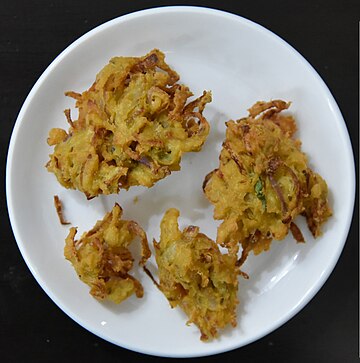Pakora (pronounced [pəˈkɔːɽa]) is a fritter originating from the Indian subcontinent. They are sold by street vendors and served in restaurants across South Asia.[5] It often consists of vegetables such as potatoes and onions, which are coated in seasoned gram flour batter and deep fried.
 Onion Pakora | |
| Alternative names | Pakoda, pikora, bhajiya, pakodi, ponako, pakura, fakkura, phulauri, bora, chop |
|---|---|
| Type | Fritter |
| Course | Appetizer or snack |
| Place of origin | South Asia[1][2][3] |
| Region or state | South Asia |
| Associated cuisine | |
| Main ingredients |
|
| Variations |
|
| Similar dishes | Kyet thun kyaw Pholourie |
The pakora is known also under other spellings including pikora, pakoda, pakodi and regional names such as bhaji, bhajiya, bora, ponako, and chop.
Etymology
The word pakoṛā is derived from Sanskrit पक्ववट pakvavaṭa,[6] a compound of pakva ('cooked') and vaṭa ('a small lump') or its derivative vaṭaka, 'a round cake made of pulse fried in oil or ghee'.[7] The word Bhajji is derived from the Sanskrit word Bharjita meaning fried.[8]
Some divergence of transliteration may be noted in the third consonant in the word. The sound is a hard 'da' in the Telugu language and the 'ra' sound would be an incorrect pronunciation. The sound is the retroflex flap [ɽ], which is written in Hindi with the letter ड़, and in Urdu with the letter ڑ.
However, in the International Alphabet of Sanskrit Transliteration, the Hindi letter ड़ is transliterated as <ṛ>, popular or non-standard transliterations of Hindi use <d> for this sound, because etymologically, it derives from ड /ɖ/. The occurrence of this consonant in the word pakora has given rise to two common alternative spellings in English: pakoda, which reflects its etymology, and pakora, which reflects its phonology.
History
An early variation of pakora appears in Sanskrit literature and Tamil Sangam literature but the recipe is not clearly provided as they only mention it as 'a round cake made of pulse fried in oil' and 'crispy fried vegetables' which were served as part of the meals.[9][10] Early known recipes come from Manasollasa (1130 CE) cookbook which mentions "Parika" (pakoda) and the method of preparing it with vegetables and gram flour.[11] Lokopakara (1025 CE) cookbook also mentions unique pakora recipe where gram flour is pressed into fish-shaped moulds and fried in mustard oil.[12]
Preparation
Pakoras are made by coating ingredients, usually vegetables, in a spiced batter, and then deep frying them.
Common varieties of pakora use onion, masoor dal (lentil),[13] suji (semolina),[14] chicken, arbi root and leaves, eggplant, potato, chili pepper, spinach, paneer, cauliflower, mint, plantain or baby corn.[15]
The batter is most commonly made with gram flour or a mixture of gram flour and rice flour but variants can use other flours, such as buckwheat flour. The spices used in the batter are up to the cook and may be chosen due to local tradition or availability; often these include fresh and dried spices such as chilli, fenugreek, ginger, cardamom, turmeric and coriander.
Serving
Pakoras are eaten as a snack or appetiser, often accompanied by chutney or raita. They are also offered with masala chai to guests at Indian wedding ceremonies.
Regional names
A gram flour fritter is known in Tamil Nadu and Sri Lanka as Pakoda or bajji, Gujarat as bhajia, in Maharashtra as bhaji, in Andhra Pradesh/Telangana and Karnataka as bajji or "Pakodi". Pakoda may be interpreted in these states as deep fried balls of finely chopped onions, green chilis, and spices mixed in gram flour.
Gallery
- Pakoras are commonly fried with gram flour
- Pakodas made from onions and greens
- Onion Pakoras with mint chutney.
- Chicken Pakoras
- Close-up of pakora containing spinach
- Onion pakora
- Bread pakora, made by deep-frying bread slices coated with gram flour
- Pakoras in Jaipur
- Chicken Pakoras
- Pakoras are also used in Khadi Pakora gravy, eaten with rice.
- Spinach Pakoras
- Khadi Pakora is pakora and yogurt based gravy eaten with rice or roti.
See also
- Bhaji – Deep fried fritters served as fast food in India, Pakistan and the Caribbean
- Bread pakora – Indian deep-fried snack
- Haggis pakora – Scottish snack food of haggis ingredients prepared as pakoras
- Pholourie – Fried, spiced dough balls
- Samosa – Deep fried pastry snack
- Vada – Category of savoury fried snacks from India
References
Wikiwand in your browser!
Seamless Wikipedia browsing. On steroids.
Every time you click a link to Wikipedia, Wiktionary or Wikiquote in your browser's search results, it will show the modern Wikiwand interface.
Wikiwand extension is a five stars, simple, with minimum permission required to keep your browsing private, safe and transparent.












